 |
|
|
Nankoweap
to Phantom Wednesday, March 11 to March 24, 2020 by Dennis Foster |
|
|
|
|
 |
|
|
Nankoweap
to Phantom Wednesday, March 11 to March 24, 2020 by Dennis Foster |
|
|
|
|
|
This trip marks the third time I have followed this particular route from Nankoweap to Phantom, with a couple of minor adjustments. The first time was in 1984 with hiking buddy Duane Ott and backcountry ranger Ralph Moore. The second time was in 1993 with colleague and hiking buddy Neil Jacobs. This time I will be with hiking buddy John Eastwood. I thought this would be a good hike for us as he closes in on having a complete hiking line from Nankoweap to Kanab Creek. And, I thought this would be better than using either the Butte Fault route from Nankoweap to Chuar (which I have been over twice) or the so-called "high saddles" route from Chuar to Clear Creek (which I have done once before) as we will be by water the first 3-4 days, lessening the loads we must carry, and because there is less elevation change involved in the climbing required to go from canyon to canyon. The text below comes from what I posted up on Facebook on my timeline, as well as on two public groups (Grand Canyon Hikers & Backpackers and Grand Canyon Hikers). I haven't changed any of that. But, I only posted up five images with each hike - the daily map and four representative photos. Here I have added in more photos to better illustrate this hike. The map comes from a screen grab I made from the tracking done by my Spot. I am unsure how to usefully save this information. So, instead I reviewed the map for each day and saved that image. I then ran them through Photoshop to erase faulty tracks (like when it bounces me back and forth across the river!) and sometimes paste in a different tracking line to capture what we actually did. The map program is interesting in that it aggregates the tracking signals based on how far you have zoomed out/in. Then it shows a number which represents the number of tracks it has aggregated. High numbers, then, mean we took a rest break here or maybe a lunch break. But, I can zoom in and see individual tracks, although with how the signal bounces around, that is rarely more informative. Day 1 - From the Nankoweap Trailhead to Marion Point (Wednesday, March 11): We left our homes in Flagstaff at about 9 a.m. in the driving rain and drove to the South Rim to drop a vehicle off at the Visitor’s Center. The rim was socked in with clouds here, but they started to dissipate a bit as we drove to Desert View. It was clear and dry the rest of the way to the trailhead – through Cameron and Marble Canyon and 20+ miles down the dirt road to the boundary of the Saddle Mountain Wilderness Area. We began hiking at 3:45 p.m. with the hope of reaching Tilted Mesa, on the Nankoweap Trail, for our first campsite. Our packs weigh in at about 45 pounds, which is low for this long of a hike, but we have a food cache waiting for us at the halfway point. About a half hour into our hike I dropped my phone, but didn’t realize it until about 15 minutes later. I retraced my steps and found it … with a crack in the screen. Lucky for me, that did not interfere with its function, which I used as my primary camera for the hike. [On the map, the black star shows where I dropped my phone and the blue star shows where I was when I realized it.] At 6:30 p.m. we reached the saddle that is at the boundary of the park and the real start, for us, of the Nankoweap. The hike up through the forested wilderness area went very well with only one short patch of snow to walk across, which is unusual for this time of year on this north-facing slope. We had thought about camping here, but at 7600 feet in elevation we were concerned that it would be too cold. So, despite the oncoming darkness we pushed on, intending to reach Marion Point (~7000 feet) before stopping for the night. It was a long slog to Marion Point, and much of it was done with our headlamps on. The ground was wet, but not especially muddy, which was especially nice at the first of the narrow, “scary,” spots of this trail where an inadvertent slip would send one down a steep slope and over high cliffs. When we reached our destination I was completely exhausted and feeling a bit nauseous. After setting up our tents, all I could muster for dinner was a cup of hot cocoa and then it was off to bed for the night. |
|
|
||
|
Click on any picture to see a larger image. |
||
|
|
||
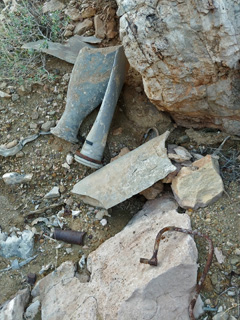 The debris we found was from the TWA Constellation. Lostflights identifies this as a propeller fragment. |
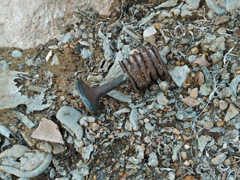 Piston and spring. |
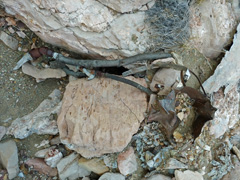 Debris. |
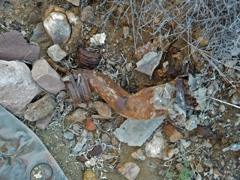 Debris. |
 Planetary reduction gear. |
|
|
Read much more about this
accident and Michael McComb's extensive exploration of this area: |
||
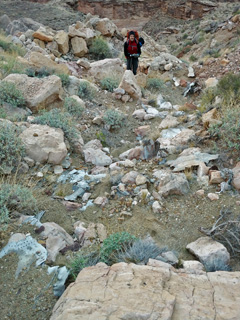 John pauses in the shallow ravine we crossed that contained debris from the 1956 mid-air collision between two commercial planes that killed all 128 passengers and crew aboard. |
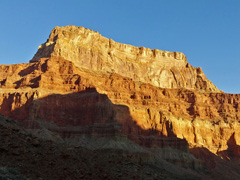 Chuar Butte gleams at sunrise. |
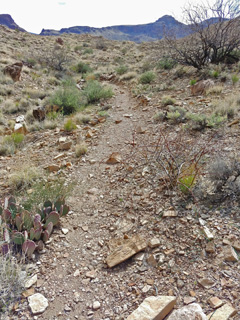 Once on the Butte Fault route, there is a well-worn trail between Carbon and Lava creeks. This must be one of the few segments of Walcott’s old trail from 1882 which is still evident. |
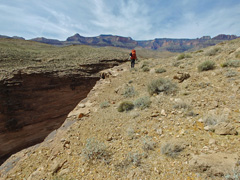 Heading west alongside Carbon. |
||
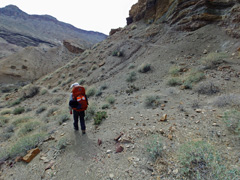 The trail has a switchback! |
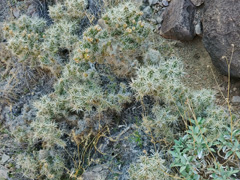 Sometimes cactus is a problem. |
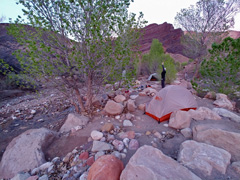 Camp alongside Lava Creek. |
|
|
||
|
|
Return to Hiking Grand Canyon home page |
|